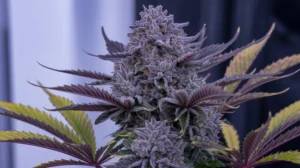THC-H and HHC-P: Unraveling the Mystery of New Cannabinoids and Safety

THC-H and HHC-P: Unraveling the Mystery of New Cannabinoids and Safety
What are you talking about? AB, THC. HHC, M, OU, SE.
THC, THC-H, and HHC-P are all different compounds found in cannabis. To explain the differences between these compounds, we can use an analogy with butter.
Imagine that cannabis is like butter, and THC is like the fat in the butter. Just as fat is the most abundant and well-known component of butter, THC is the most well-known and abundant compound in cannabis.
Now, let’s say that THC-H is like a different type of fat that can also be found in butter. This fat is less well-known and less abundant than the main fat, but it’s still a significant component.
Finally, HHC-P can be thought of as a rare and lesser-known compound found in butter. It’s like a rare and lesser-known compound found in cannabis that isn’t as well-studied or understood as THC or THC-H.
So, in summary, just as butter has different types of fats, cannabis has different types of compounds. THC is the most well-known and abundant compound, THC-H is a less well-known but still significant compound, and HHC-P is a rare and lesser-known compound that is not as well-studied.
Welcome to the World of THC-H and HHC-P
Just when you thought you had a grip on the cannabis world, along come THC-H and HHC-P—the new kids on the cannabinoid block! These fresh-faced cannabinoids have burst onto the scene, eager to show off their potential therapeutic effects. But before you invite them to your next dinner party, let’s get to know them better. In this playful yet informative guide, we’ll dive into their origins, properties, and safety profiles. Ready to embark on this whimsical journey? Let’s go!
Once Upon a Time: The Origins of THC-H and HHC-P
In a world filled with cannabinoids like THC and CBD, it was only a matter of time before new characters entered the stage. Introducing THC-H and HHC-P, the latest additions to the cannabis family tree.
THC-H, or tetrahydrocannabinol-homolog, is a cousin of THC, the star of the show in cannabis plants. It came to life through biosynthetic modification, resulting in a compound that shares a striking resemblance to THC but with a unique twist.
HHC-P, or hexahydrocannabinol-pentyl, made its debut as another rising cannabinoid. Like THC-H, HHC-P is a derivative of THC, born through hydrogenation and other chemical shenanigans. This transformation leads to a distinct molecular structure with a hint of therapeutic magic.
A Tale of Two Cannabinoids: Chemical Properties and Effects of THC-H and HHC-P
Now that we’ve met our protagonists, let’s delve into their unique properties and potential effects. After all, every superhero has a secret power, right?
THC-H: The Mild-Mannered Cousin of THC
THC-H may look like THC, but it has a secret identity: an extra carbon atom in its molecular chain. This seemingly small change has a significant impact—it gives THC-H a lower affinity for the CB1 receptor, which means it’s less likely to cause the psychoactive effects associated with THC. This gentle soul retains many of the therapeutic benefits of its more potent cousin while flying under the radar.
HHC-P: The Anti-Inflammatory Dynamo
HHC-P is the result of adding hydrogen atoms to the structure of THC, creating a fully saturated and stable compound. This molecular makeover gives HHC-P a high affinity for the CB2 receptor, which plays a crucial role in regulating the immune system and inflammation. As such, HHC-P may be the unsung hero in the fight against inflammation and pain, without the psychoactive side effects of THC.
The Adventures of THC-H and HHC-P: Potential Therapeutic Benefits
As research on THC-H and HHC-P continues, these cannabinoids are revealing their hidden powers. Here are some of the potential therapeutic benefits they might bring to the table:
- Pain relief: Both THC-H and HHC-P could be the heroes we need in the battle against chronic pain, providing relief without the mind-altering effects of THC.
- Anti-inflammatory effects: HHC-P’s secret weapon is its affinity for the CB2 receptor, which may give it powerful anti-inflammatory properties—perfect for combatting conditions characterized by inflammation.
- Neuroprotective properties: Early intel suggests that THC-H may have a hidden talent for neuroprotection, potentially offering benefits for neurodegenerative disorders like Alzheimer’s disease and Parkinson’s disease.
- Antispasmodic effects: HHC-P appears to be flexing its antispasmodic muscles in preliminary research, which could be a game-changer for patients dealing with muscle spasms or spasticity.
- Reduced anxiety and stress: The milder psychoactivity of THC-H makes it a suitable sidekick for those seeking relief from anxiety and stress without the mind-bending effects of THC.
Safety First: The Untold Story of THC-H and HHC-P
As with any mysterious new compounds, it’s crucial to learn about the safety profiles of THC-H and HHC-P before they can save the day. Initial findings suggest that these cannabinoids may be more mild-mannered than their notorious cousin, THC, thanks to their reduced psychoactivity and potential therapeutic benefits.
However, we must be cautious, as their long-term effects on the human body remain largely uncharted territory. Like any responsible superhero, it’s essential to consult with a healthcare professional before introducing THC-H or HHC-P into your wellness routine.
The Legal Labyrinth: Navigating the Legal Status of THC-H and HHC-P
The legal status of THC-H and HHC-P is a complex web of regulations that vary depending on the country or region. In some jurisdictions, these cannabinoids are classified as controlled substances, while in others, they may be considered legal for use under certain conditions. To avoid any unexpected run-ins with the law, be sure to familiarize yourself with the specific regulations governing the use of THC-H and HHC-P in your area.
A Glimpse into the Future: Upcoming Research and Potential Applications
As the story of THC-H and HHC-P unfolds, we eagerly await further research to uncover more information about their properties, safety profiles, and potential therapeutic applications. Scientists and clinicians alike are hopeful that these novel cannabinoids will prove themselves as valuable allies in the treatment of various medical conditions, with fewer side effects than traditional cannabinoid-based therapies.
In conclusion, THC-H and HHC-P are like superheroes in the making, with the potential to revolutionize the world of cannabinoid therapy. However, as with any emerging compounds, their safety and efficacy must be thoroughly evaluated through rigorous research before they can be widely adopted as therapeutic agents.
Suggested Articles
;)
;)
;)




 16 Dec 2025
16 Dec 2025  7 min read
7 min read


 April 18, 2023
April 18, 2023 


RESPONSES (0)
No responses yet. Be the first to respond!